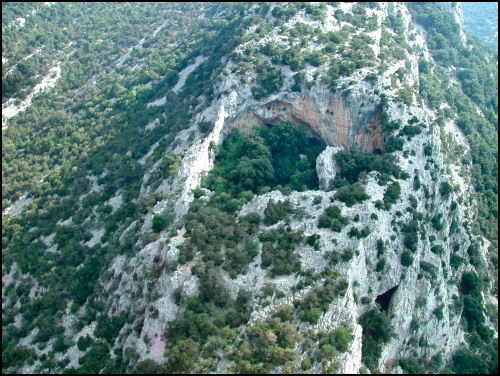


home about us archaeology excursions sea offers territory contact link gallery

|
The ancient village of Tiscali was built inside a cone-shaped dolina (a depression in the earthís surface) at Mount Tiscali in the centre of the Supramonte highland. The dolina was created by natural forces when the roof of a cave fell through and became covered by vegetation. The Supramonte massif is made up of limestone rocks dating from 160 - 180 million years ago (Jurassic). The Karst phenomenon of limestone erosion over millions of years is responsible for what we see: a seemingly limitless array of gorges, cliffs and caves. When they arrived inside the dolina, the people who built the village would have found similar conditions to what we see today. Manís presence in Tiscali has to be compared with that in the Lanaittu valley below. After 10 or so archaeological excavations in the nearby Corbeddu cave, we can be sure that Lanaittu has hosted various cultures from 12-14,000 years ago up until today, but in Tiscali it is very difficult to give a precise date to when the village was built and inhabited because no official digs have been carried out. The first archaeologists came in the early years of last century (Antonio Taramelli and Ettore Pais) but their visits basically involved quick inspections, a census of the huts and the collection of surface ceramics from the Nuragic and Roman periods. The most likely assumption about the people who lived here is that they came from the Lanaittu valley, perhaps because of conflicts with neighbouring populations but more probably because the arrival of Romans prompted them to abandon their homes in the valley to take refuge inside the mountain. It remains difficult for us to believe that Tiscali was inhabited continuously, for three important reasons: 1) Itís almost impossible to find natural springs in calcareous soil and rock for an uninterrupted supply of water. These people would have had to gather and conserve their water every day as it slowly seeped from the walls of the dolina, and they did so by building little cisterns to keep it for when it was really needed - in the summer. 2) Itís almost impossible to cultivate crops in these mountains and itís also very difficult to rear animals here. 3) If these people had escaped from an enemy they would have avoided leaving signs of their presence. Bearing all of this in mind, Tiscali remains a mystery. Two groups of huts make up the village. The first group is in the north near the entrance and includes about 40 huts, some of which are circular, but most of them are rectangular-square. The walls were built with just one uneven row of stones held together with a lime and mud mortar. The huts give the impression of being very rushed and fragile constructions. The entrances were wide with turpentine wood lintels. The roofing was made from juniper trunks and branches. The second group lies in the south-west of the dolina and includes more than 20 huts, all of which are of a rectangular design, slightly smaller in size than those of the first group. It is hard to believe that they represented shelter for families and itís more likely that they were used as stores for supplies or shelter for domestic animals. As in the first group, the roofing was made of juniper. Itís worth noting that inside the dolina there is a small forest full of centuries old trees among many species of Mediterranean vegetation, and exceptional examples include turpentine, oak, phillyrea, mastic, fig, maple and ash trees. |
|
|
|
 |
|
Month |
Opening times |
|
Genuary-February-March-April-November-Dicember |
09:00 - 17:00 |
|
May-June-July-August-September-October |
09:00 - 19:00 |
|
Ticket: Full price 5.00 euro, Concession price 2.50 euro. |